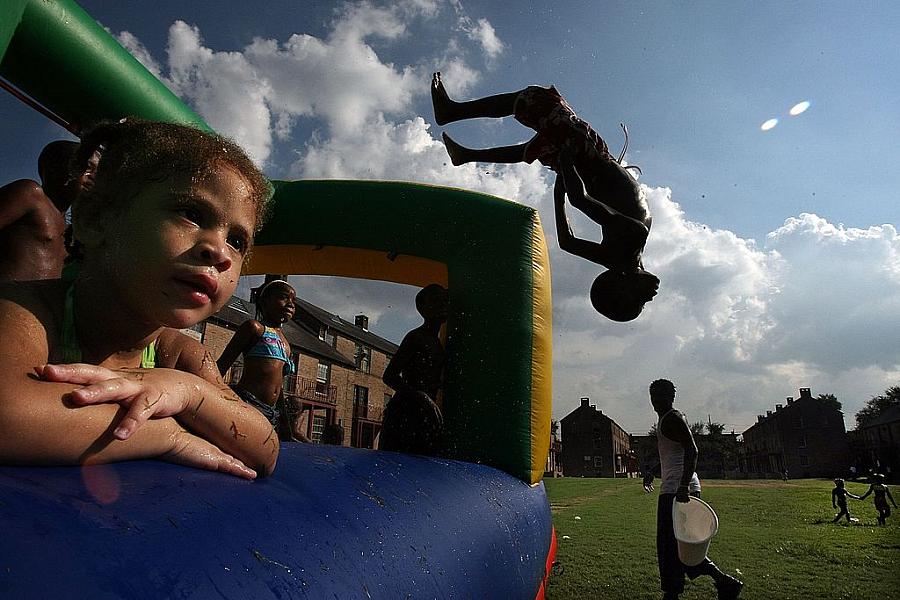Could a new test finally tell us if kids are suffering dangerous levels of stress?

(Photo by Mario Tama/Getty Images)
Researchers are developing a new tool to measure whether children are experiencing the physiological effects of toxic stress, a development that could have far-reaching implications for pediatricians and families.
The JPB Research Network on Toxic Stress, led by Harvard University professor Dr. Jack Shonkoff, is composed of academics from across the country who hope to deliver a biological test for childhood adversity in the next few years.
“The goal in reality is to identify biomarkers that are scalable, that would raise red flags that would tell the pediatrician: ‘There's something going on here. I don't know exactly what it is, but maybe I should dig a little deeper,’” said Pat Levitt, a University of Southern California professor of pediatrics and neurogenetics researcher involved in the project.
Chronic stress early in life has been found to put a person at increased risk for a variety of physical, mental and educational problems, and even change the architecture of the brain. Those findings have gained broader awareness in recent years, as journalists have increasingly reported on the effects of toxic stress on children across the nation.
But so far there hasn’t been an easy way to quickly detect dangerous levels of stress in pediatric settings — so that’s the missing tool the team of researchers is trying to develop. This could also change the way health journalists report on early childhood adversity and interventions, by giving a quantifiable way to gauge stress and resilience in kids.
“We are getting progressively closer to having objective, biologically based ‘readouts’ of toxic stress, but there remain two challenges,” said Charles Nelson, a professor of pediatrics and neuroscience at Harvard Medical School who is also associated with the project. “A: Will they work at the level of the individual child? And B: Do they have high specificity? That is — are they picking up a ‘signature’ of toxic stress per se or something broader? My sense is it will still be three to five years before we solve these problems.”
If and when that happens, Levitt said such a measurement tool would be a “game-changer.” That’s because, he noted, there are “things that can buffer toxic stress: strengthening the caregiver skill sets, particularly on executive function; reducing stress levels in the (family) environment; (addressing) mental health issues of the primary caregiver.”
The interventions often focus on the parents, and their past traumas, as much as the children, and involve increasing “serve and return,” a term that refers to the social connectedness and interaction between young kids and their caregivers.
Levitt compared it to the treatment for autism: “While we don't have a ‘cure’ for autism spectrum disorder, we do have a situation in which more and more kids are getting earlier and earlier interventions, and they're doing much better than those who are getting interventions later.”
The tool for measuring toxic stress will likely consist of a battery of tests — potentially using samples of saliva, DNA and hair, as well as electroencephalograms or EEG — that can collectively detect elevated stress responses in the body. Such analyses would look for factors like an increase or decrease in certain immune proteins, epigenetic changes, and damage to telomeres, which are protective caps at the end of chromosomes and a measure of cellular aging, Levitt said.
As Levitt explained, “A toxic stress response is really an attack on what we call ‘regulatory processes,’ which is a fancy term for another, single-word term: homeostasis. That is, all our physiological systems become imbalanced. … If it doesn't return back to baseline, or back to normal, but it maintains some chronic state, that's when the the problems occur — what we call a ‘physiological load.’”
The current approach from pediatricians is to examine developmental milestones — speech, language and motor-skills — as well as the quality of social interactions between the child and caregiver and even the parents’ mental health, Levitt said. But this approach is limited, in part because primary care providers are generally stretched for time. Research has found that only about a third of kids receive any type of developmental screening.
Some pediatricians also screen for adverse childhood experiences, but often aren’t reimbursed for their times. California recently became the first state to pay health care providers to do these evaluations, under the state’s Medicaid program. However, some experts have been skeptical about the effectiveness of these screenings, and the biomarker battery could eventually supplement — or even replace — them with a more objective approach.
Levitt predicts this will be a “front line” test, like ones required in certain places for lead exposure.
But some parents might have misgivings about getting the biomarker analysis, either because they’re worried about the potential for child welfare involvement or their kids being stigmatized as victims of abuse, trauma or neglect. This could be particularly true for communities of color, whose wariness stems from a long history of unscrupulous medical research.
That’s why, Levitt noted, the research consortium includes community leaders who are addressing these and other ethical issues, as well as how to get community buy-in.
The tool could also be used to measure the efficacy of various early-childhood interventions, by telling us which ones are more effective in returning kids’ stress levels to normal. In addition, researchers have said such biomarker tests could help detect the physiological underpinnings of why some kids can better withstand or overcome the negative effects of adversity.
“If we can identify the genesis of the toxic stress response,” Levitt said, “it should mean we can identify the genesis of building resilience.”

